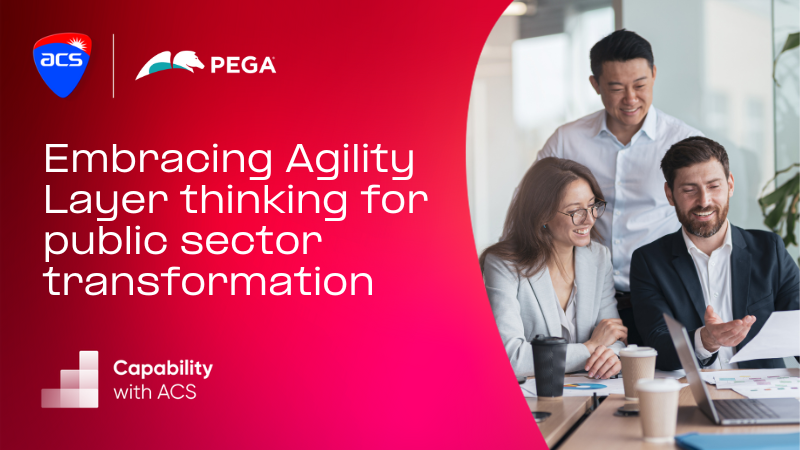
Embracing Agility thinking for public sector transformation – Robert Bollard PSM, PegaSystems
Highlights
Managing risk, value and change while undertaking digital transformation is a challenge
Rob Bollard discusses the benefit of an agility layer to manage complex digital transformation.

Current research suggests the bleak statistic that between 70% to 80% of all major digital transformation programs fail within the public sector. There is an increasing narrative within government to move towards smaller more agile components of work to deliver value faster and avoid the risk of large costly transformation failures. I would agree that this path is the best approach to delivering on agency strategic and operational outcomes.
From my experience over many years undertaking highly successful public sector transformation - it is never the current or future state that has been the main challenge rather the journey to move from old to new seamlessly whilst appropriately managing risk, value and change. Some describe this as rebuilding the new plane as you are in the air. I think of it more as building an ongoing technology pipeline to deliver constantly evolving organisational outcomes. Certainly, as a CIO within Federal Government – it was a core philosophy that served me well in navigating what can often be complex and challenging journeys.
This is especially true for large government agencies that have significant complexity at scale. However, design thinking around the citizen now has exponentially raised the complexity bar even for smaller agencies as they are orchestrated together around the citizens needs and the demand to holistically connect across public, private and not for profit sectors to action outcomes. The desire for a joined-up government around the citizen requires new thinking that holistically not just impacts technology but also people, processes and culture.
The modern public sector transformational leader can deliver agile value and significantly de-risk, but it requires a holistic approach to deliver on the vision. One of the foundational pieces I recommend as a must is consideration of a platform approach to delivery in order to create an agility layer over the often complex and aging technology estate faced by many agencies and government in general. This supports a more seamless journey that can wrap and renew to manage the change whilst allowing faster time to value. This innovative approach acts as a linchpin, enabling agencies to better navigate the complexities of digital transformation and cushions the impacts of ongoing change.
At its core, an agility layer is delivered on a dynamic platform that facilitates flexible, rapid, and efficient adaptation of IT systems and processes though user journeys. It acts as a bridge between traditional, legacy systems and modern, agile technologies. This layer comprises a set of tools, methodologies, and best practices that empower organizations to respond swiftly to changing demands, technological advancements, and citizen expectations.
One of the primary benefits of an agility layer is its ability to enhance operational efficiency. By integrating agile methodologies, automation, and DevOps practices, agencies can streamline their IT workflows. This streamlining minimizes manual intervention, reduces errors, and accelerates the delivery of IT services. Consequently, organizations can optimize their resources, boost productivity, and achieve higher operational efficiency.
Scalability and flexibility are paramount in the realm of IT transformation. An agility layer provides agencies with the scalability to expand their IT infrastructure effortlessly. Whether it's accommodating a surge in user traffic, onboarding new applications, or expanding to new programs of work, the agility layer ensures that the IT ecosystem can scale horizontally and vertically as needed. Moreover, this layer imbues them with the flexibility to pivot, innovate, and experiment with new technologies without disrupting existing operations.
So, for example - in the fast-paced digital landscape, data-driven and responsible AI decisioning is becoming fundamental to success. An agility layer empowers agencies with data, real-time analytics, automation, insights and decision support. By harnessing the power of data and responsible AI, organizations can make informed, engage agile decisions and deliver to done. These insights enable agencies to identify trends, drive efficiency and effectiveness of service, and surface operational bottlenecks, allowing them to iterate their strategies swiftly and deliver improved strategic and operational outcomes.
In my opinion Governments undertaking major technology transformations must seriously consider a platform approach to delivery. By enhancing operational efficiency, enabling seamless integration, facilitating scalability and flexibility, and empowering agile decision-making, agencies can navigate the complexities of digital transformation with confidence and a focus on value. Embracing the agility layer not only future-proofs IT infrastructure but also positions organizations as leaders in the digital era. As agencies continue to evolve, the agility layer stands as a beacon, guiding them toward smooth change management, innovation, and unparalleled success in the ever-changing world of technology.
About the ACS Canberra Hub
The Hub is a custom-built collaborative space for members to drop by and use as a hotspot for meetings and events. Meeting room hire is also available to members and non-members.
Click here to find out more about the room hire rate or click here to book a room for your next meeting/event.
